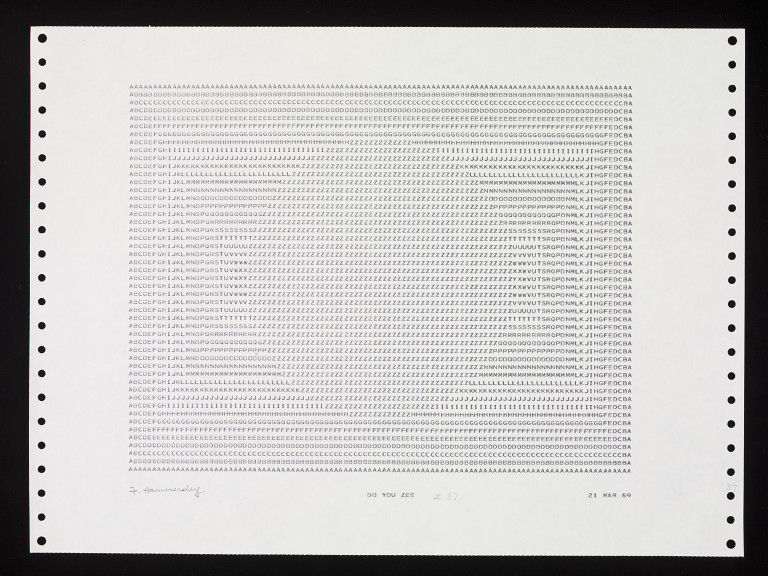Event 1: Aaron Marcus: Early Works
I went to the event of Aaron Marcus: Early Works at the Berkeley Art Museum and Pacific Film Archive (BAMPFA). There, I saw some great artworks that illustrate the “Third Culture,” which bridges between science and art.
In this event, I saw the works of two artists. The first artist is Aaron Marcus. Educated in physics, mathematics, and philosophy at Princeton University and trained in graphic design at Yale, Aaron Marcus explores new possibilities for expression. He created his first “computer-assisted poem-drawings” in the spring of 1972. His artworks also illustrate the theme of art + robotics. Marcus experimented with a photo-typesetting machine connected to a digital computer, reordering the symbols and their uses to create new meanings.
It is the first time for me to see “computer-assisted poem-drawings,” a phrase that I have never heard of before. In these drawings, I saw his creativity with new visual representations of words.
 |
| picture I took |
For instance, this painting is named “gravity.” In this static drawing, I can feel a sense of motion. Looking from top to bottom, I can imagine that due to gravity, the lines are falling, filling up the empty squares and circle. Therefore, at the bottom, the squares and the circles are filled, and fewer vertical lines are shown.
This drawing is fascinating to me too. At first glance, I can see three colors in it: red, yellow and orange. As I looked more carefully, I found out that the painting is full of letters “H” in yellow, and the color of the background is consistent. I never thought of changing the spacing between letters can create a sense of color transition. In these artworks, Marcus makes connections between art, science, design, and visual poetry.
Besides the benefits of seeing these fascinating paintings I mentioned above, I would recommend this event because it made me I realized a new definition of "art" and how technology has helped to create art much more easily. After looking at the artworks of Aaron Marcus, I saw the works of the second artists, who is also the pioneer of computer-assisted drawing, Frederick Hammersley. Here is the wall of his computer-assisted drawings.
 |
| Picture I took |
A unique painting that I paid attention to is this. It is named “Do you Zee.” I took a closer look into the painting, and I found out it is just a simple alignment of the 26 English alphabets. However, the number 37 is hidden in the pattern of these letters.
 |
DO YOU ZEE, Hammersley, Frederick
|
 |
| Selfie with sticker given by museum |
Before this event, I always thought that the creation of art is a challenging task for me, and I do not consider myself as someone who has the potential to be an artist. However, these computer-assisted drawings helps me with my midterms and final for this class by giving me a sense of confidence that art creation can be simple; drawings can just consist of letters, without colors. Moreover, everyone can be an artist, not only people with the talent to draw beautifully. I think after seeing computer-assisted paintings like these, my classmates who are not convinced that they too, can be artists, will be more confident in their artistic ability. Hopefully, they can be inspired to create their computer-assisted artworks with their imagination and whimsy.
 |
| Me and staff at BAMPFA |
“Aaron Marcus: Early Works.” BAMPFA, bampfa.org/program/aaron-marcus-early-works.









No comments:
Post a Comment